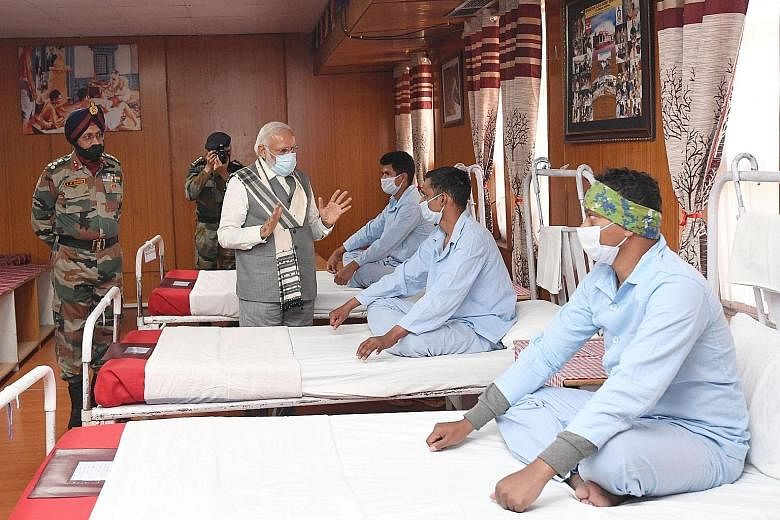Soon after a deadly clash between Indian and Chinese troops in Ladakh on June 15, a tweet from Prasar Bharati (PB), India's public service broadcaster, received wide attention. It urged people to turn to its Tibetan and Mandarin services on All India Radio (AIR) for "authentic news and programmes", and listed various ways they could tune in, including via their YouTube channels and shortwave radio.
Governments worldwide have long used broadcasting services as a public diplomacy tool. India's government is no different, broadcasting in English and as many as 15 other foreign languages and dialects, including Tibetan and Mandarin, on AIR.
It is an asset that Prime Minister Narendra Modi's government has turned to with renewed vigour now. Programmes in Tibetan and Mandarin in recent weeks have been supplemented with additional news content reinforcing New Delhi's stance on the border row and ongoing tension with China.
For instance, a news post on the Tibetan-language service's portal - a modest blog hosted on Blogger - on June 18 accused China of violating the status quo along the Line of Actual Control (LAC) which makes up the de facto border between India and China.
A commentary dated July 2 on the same site spoke of growing global criticism of China following the passage of the new controversial security law for Hong Kong.
Posts on the Mandarin portal of AIR have similarly accused China of violating de-escalation plans that were agreed upon as well as attempting to change the current situation along the LAC.
The PB chose not to respond to queries from The Sunday Times on its foreign language broadcasts but Indian media outlets, quoting unnamed government officials, have since the clash reported on plans to augment services in the Tibetan language. New content would focus on "India's democratic and cultural traditions, its connections with Buddhism, influence of India on Tibet and the status of Tibetans in India," said The Economic Times.
The AIR's external services began as early as 1939 with its programmes in Pashto for listeners in what was then British India's North West Frontier. The service was aimed at countering radio programmes from then Nazi Germany, directed towards Afghanistan, Iran and Arab countries.
There is little knowledge of how many listeners in Tibet tune in to AIR's services today as shortwave frequencies are often blocked and Internet platforms have firewalls.
Indians, however, continue to access television programmes from China Global Television Network, an international English-language news channel owned by the Chinese government, as well as radio broadcasts in several Indian languages, including Hindi, Tamil and Bengali, from the state-owned China Radio International.
The renewed focus on AIR's foreign language services comes after years of neglect that have stymied these services and made them less appealing. The reasons include limited funding, poor quality of programmes, lack of staff and slow adoption of new technologies.
-
Clash over coverage
NEW DELHI • Last month, Prasar Bharati (PB) criticised the Press Trust of India's (PTI) coverage of the India-China clash as being "detrimental to national interest" and alleged that it had undermined India's territorial integrity. PB even threatened to cancel its subscription to the news agency's services.
PB's attack came after PTI interviewed the Chinese ambassador to India, Mr Sun Weidong, on June 25. The Chinese embassy had put out a truncated version of the interview on its website featuring questions like "How do you see the face-off in Galwan Valley?" and "How do you think the current dispute can be resolved?"
In his responses, Mr Sun claimed the incident was "completely instigated by the Indian side" and accused Indian soldiers of crossing over to China's side of the Line of Actual Control (LAC). The lack of probing questions prompted criticism of PTI but the agency, in a statement to The Sunday Times, said the criticisms were "unwarranted, unjustified and unfair".
It said: "It is clear the one-sided criticism of the PTI interview has been generated by the truncated version put out by the Chinese embassy. In fact, there were a number of questions put to Ambassador Sun, including many that challenged his narrative."
The agency had also interviewed the Indian ambassador in Beijing, Mr Vikram Misri, and quoted him on June 26 in a tweet saying that Chinese troops needed to move back to their side of the LAC - a statement that contradicted Prime Minister Narendra Modi's claim that "no one has intruded" into India.
Many have linked PB's outburst - also widely criticised - to these developments.
Debarshi Dasgupta
AIR's Tibetan service used to be popular in the 1960s and 1970s among Tibetans living in India but today, most of them have switched to other Tibetan-language services from providers such as Voice of Tibet, Radio Free Asia and Voice of America.
"I haven't heard AIR Tibetan service since I was seven, the year I went to Mussoorie for schooling," said Mr Lobsang Wangyal, 50, a senior Tibetan journalist based in McLeod Ganj in the state of Himachal Pradesh.
"It used to be very popular with my parents' generation," said Ms Tenzin Peldon, the editor of Voice of Tibet, a Norway-based radio service. She said AIR will have to increase the duration of its programming, adopt social media channels more vigorously and focus more on features documenting Tibetan culture and Buddhism instead of just generic news items to stay relevant.
"It is important for AIR to revamp its Tibetan radio service because a large chunk of the exiled Tibetan population lives in India," said Ms Peldon. It is estimated that 100,000 Tibetans live in India. "Its programmes are of relevance not just for Tibetans but also other communities in India, such as the Sikkimese and Monpas, who share their culture and religion with Tibetans," added Ms Peldon.

